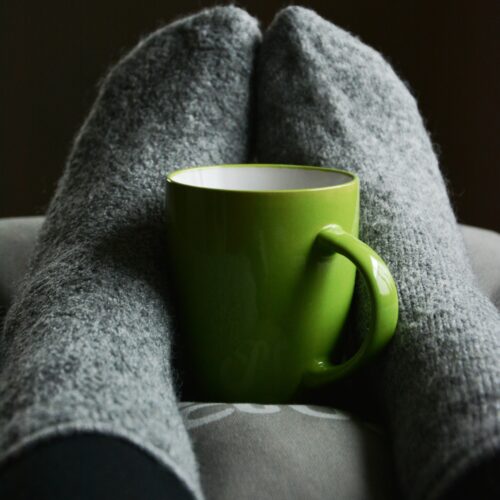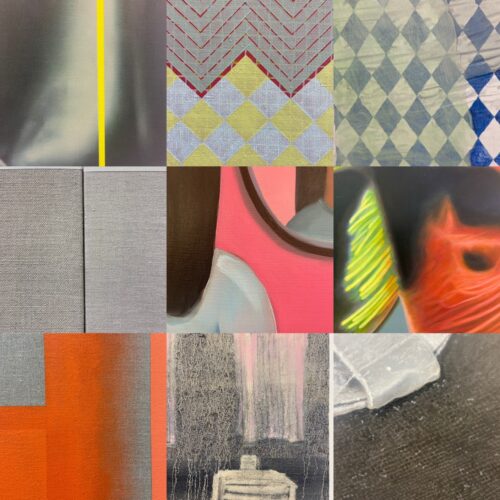
Art_Textile Review
On the 20 November a group of textile students and myself made the journey to The Whitworth Gallery, Manchester to see the Art_Textile exhibition. The show spans several rooms and many materials, styles and techniques associated with textiles. Some like Magdalena Abakanowicz’s piece Abakan Rouge III are iconic in the world of contemporary textiles, loading it with preconceived understanding and knowledge. I was however impressed with the scale and the frankness of the weaving technique. In the exhibition notes I was disappointed to read that once Magdalena had given up weaving in the 1970’s she felt herself to have escaped the ‘craft ghetto’. This subtle dismissal of textiles as a valid art form was also present in the introduction of the exhibition notes, with the opening sentence ‘Textiles is having a moment’. This long history of condescending textiles appears to be lingering on in some peoples minds but it made myself and I suspect many of the students with me feel more determined to ignore the prejudice and change those minds. If you are interested in how this attitude towards textiles came about I suggest you read The Subversive Stitch by Rozsika Parker.

Despite this negative introduction to the show there were many exciting highlights. For me probably the most intriguing and surprising work was Better Days by Susan Collis. It consisted of an embroidered dustsheet, the type used by decorators that was placed seemingly carelessly on the floor of the gallery. At a glance it appeared not to be an artwork at all but a paint splattered rag left by a forgetful member of the gallery staff. But closer inspection revealed that the ‘paint splatters’ were marks made by embroidery and the subtle stains were threads woven into the sheets surface. The more I looked the more I saw with a growing sense of wonder at the skill and the formulation of the idea.

This feeling of being drawn ever closer to a piece of textile art is a common sensation for me. I want to get close enough to see and understand how each often tiny stitch makes the whole. This was certainly the case with Anne Wilson’s Dispersions series where the handling of the hand embroidery in making miniature stitches that layer and mingle create a painterly surface. A painterly effect was also created by Do Ho Suh in the work Myselves where the artist has embedded threads in cotton paper. The colour and movement of the lines along with the illustrative quality in this work creates an expressive depiction of the human form.


Personally I found inspiration in the artworks of the Abstract Landscape exhibition, in colour, forms and composition. I enjoyed the energy and playfulness of these pieces. As is my habit I made brief pencil drawings, wrote notes and took photographs. These became useful when I later met up with a number of the students chatting in the café. They had been getting to know one another and discussing their experiences of studying with the OCA. As it often does at study visits the subject of drawing came up. Textile students often lack drawing experience as very often their love lies in textile materials and acquiring technical skill. Part of the problem I think is that students often haven’t been told or understand the purpose of making these pictorial notes. A shortage of experience and understanding can lead to a reduced confidence blocking the pathway to developing ability.

Drawing is a learnt skill in the same way writing is, it takes practice to master and results in individual style, just like handwriting. I think that knowing why students are expected to draw and what this may look like is a vital hook into developing the skill. So back to the conversation in the gallery – my explanation to the students probably helped but once I showed them the crude sketches I’d just made I could see they understood what I was attempting to communicate. Seeing the drawings along with my annotation the students were able to comprehend how and why drawing is part of the research and wider design process. For me this is the joy of teaching – facilitating understanding and development in students. I want to thank them for being part of this conversation, being open to the learning experience and giving me the opportunity to share this conversation with the wider OCA community.
I am planning another study visit to the Whitworth Gallery early next year where I plan to arrange spending some time exploring the gallery’s archive of contemporary textiles. Art_Textiles continues until the 31 January 2016.






Thank you Rebecca for this review. And thank you for sharing your notebook! I understand by now that Whitworth is quite a textile nucleus in the UK. I would love to come at some point (but as it would involves a plane and hotel, so not too easy, nor cheap). But being able to read this as well as the reports by fellow student really helps. It does give some ideas on how I could try to make my own ‘study visits’ – although without tutor input it would naturally be quite another thing (without the lovely coffee-talk).
I echo Inger’s comments above, Rebecca. As a Level 1 student it is useful to read your commentary on the textiles work as well as your points about drawing. From reading about the exhibition, the Susan Collis piece has caught my attention in particular.
Is there any chance that a study day could be on a weekend or in school holidays to give those of us who work the possibility of attending?
Unable to join the study visit, i went to this exhibition separately and found it truly inspirational and hope to do a return visit before the end of January, as there is much to see and absorb. I also was a bit taken aback by the openeing comment .. “textiles are having a “moment” – what a put down ! However, just starting “Exploring Ideas on level 1, it has given me lots to think about.
Also found your comments, Rebecca, about drawing really helpful, as i keep going back to mark making and sketching and appreciating that drawing is a skill to learn rather than necessarily being a natural flair has given me confidence.
More study visits in the north please
Thank you for sharing your insights on this study visit to The Whitworth Gallery in Manchester, Rebecca, to view the Art Textile exhibition. I really appreciate that you took the time to record it. It is always interesting to read about study visits. One of the reasons for this is that I have never been able to attend one.
I note that Art_Textiles – runs 10 October to 31 January 2016 and is free entry if any reader is able to go to Manchester during that period for 10am until 5pm. Anne Wilson, Beverly Ayling-Smith, Elaine Reichek, Faith Wilding, Ghada Amer, Grayson Perry, Jagoda Buic, Jessica Rankin, Kimsooja, Laima Orzejkauskiene, Lyn Malcolm, Mary Sibande, Maxine Bristow, Michele Walker, Risham Sayed, Shelly Goldsmith, and Tracey Emin were other artists represented at the exhibition. What a wonderful line up. Each of the artists mentioned have books available from the publisher listed below. The book of the exhibition can be bought from http://www.cornerhousepublications.org/publications/extraordinary-art-and-textiles-since-1960/. It does sound an intriguing and fascinating visit for Textiles students! I wish it was possible to go, but maybe the book is the next best idea if you were unable!
Living in Spain, it is not easy to coordinate the dates and places of study visits, even if I manage to visit the UK during the year. I know there is a small percentage of OCA students who face the same issues. Perhaps there could be a student represented response to this idea, to enable students who do not live in the UK, opportunities to mimic study visits and further their creative journey whilst studying? This is one of the underlying issue for the lack of confidence among textile students when either viewing exhibitions or who are scared off sketchbook work whilst walking around them. It was very useful to see the sketches you had taken Rebecca, and a good reminder to make this part of an exhibition visit.
What I found helpful, was knowing which artists had been represented at this particular exhibition and also how you as a tutor, as well as any OCA students, personally responded to the exhibits… it would be good to hear from more of you! Rebeccas response has helped me to consider, in more depth, how to respond in my sketchbook or photographs, to the local exhibitions, or international exhibitions, that I am able to visit in other countries {which are unfortunately rarely textile related}.
Which brings me to another point. If Textile students visit exhibitions, outside of study visits, is there any relevance mentioning it in their blog or notes to their tutor, or when considering assessors viewpoints? Given that assessors rarely want to read anything outside of the coursework one does? I am sorry to be going a little off topic, but I feel they are relevant issues, wand I do not know how to resolve them.
I do consider the point you made about artists like Magdalena Abakanowicz and her dismissal of textile art as an art form, very pertinent to our studies. But I ask how much her opinion matters, given that she gave up weaving in the 1970s? The commentary on Textiles as an art form, continually raises exciting questions in artists about the place of the handmade, and often in my own mind at least, it’s lifespan and its associations with women and domesticity, within our increasingly techno driven, industrial and urban culture.
I would love to be present at your next visit to the Whitworth in early 2016 Rebecca, it would be fascinating to experience the Whitworth’s archive of contemporary textiles. I look forward to more details.